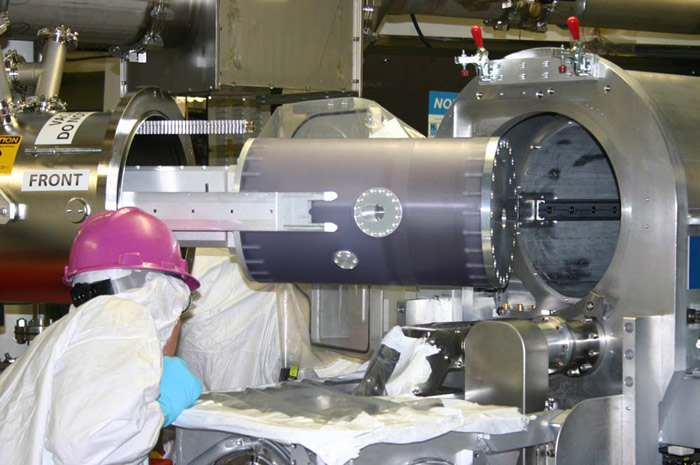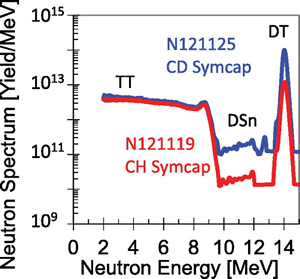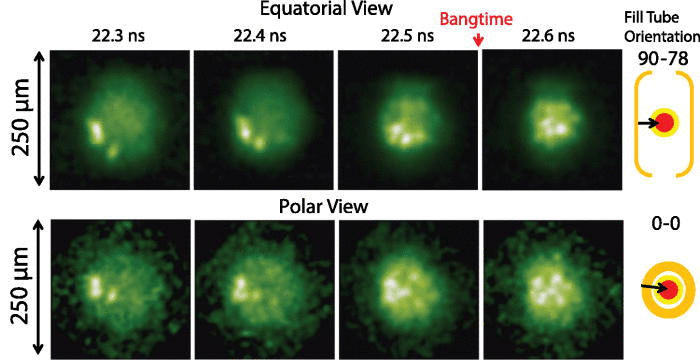Papers and Presentations - 2014
September
NIF Experiments Mimic Atmospheric Blast Effects
The results of NIF experiments designed to simulate the effects of atmospheric explosions, both in the air and on the ground, were reported by LLNL researchers and colleagues in a Review of Scientific Instruments paper published online on Sept. 26.
In the Energy Partitioning/Energy Coupling (EPEC) experiments, conducted in support of NIF’s National Security Applications mission, a source target is positioned above a simulated ground-surface and is heated by four NIF beams. The laser beams create a high energy density source that drives blast waves in a test atmosphere and shock waves in a ground medium. This blast-and-shock simulator can be used to study the partitioning of the source energy into air blast and ground shock as a function of the height of burst of the target. It also can be used to study the response of different geological media and to study the efficiency of coupling to the ground as a function of source energy.
 (Left) Graphic shows a diagnostic instrument manipulator (DIM) inserting an EPEC pressure cylinder into the NIF target chamber. (Right) The interior of the cylinder with a target, air-blast sensor, and ground surrogate installed.
(Left) Graphic shows a diagnostic instrument manipulator (DIM) inserting an EPEC pressure cylinder into the NIF target chamber. (Right) The interior of the cylinder with a target, air-blast sensor, and ground surrogate installed. NIF is a unique facility for developing this experimental platform: only a NIF quad of beamlines can supply enough energy from a small-enough solid angle to create the energy density in the target needed to simulate the detonation of a low-yield nuclear device. Having all the energy come from a single quad means the target’s laser entrance hole (LEH) can be quite small, which minimizes losses and keeps the energy in the target and available to create the blast and shock phenomena of interest to this study. A special set of four small-spot-size phase plates (NIF focusing optics) was created specifically to get the quad of NIF beams into the small EPEC LEH. The energy available from a NIF quad—about 10 kilojoules in this case—creates conditions that are equivalent to the conditions surrounding a one-kiloton (KT) nuclear detonation; researchers then study the associated blast and shock phenomena over distances of several centimeters and on time scales of milliseconds.
The EPEC experiments rely on the principal of hydrodynamic scaling to study the strength of shocks and the velocities of shock propagation that are the same as would be achieved with high-energy sources in full-scale field tests. The EPEC phenomena, however, take place over spatial and temporal scales that are orders of magnitude smaller than the full scales. The platform provides data from a well-controlled set of conditions that can be used for validation of codes.
In the Review of Scientific Instruments paper, lead researcher Kevin Fournier and colleagues report agreement on the order of a factor of two to three between the experimental data and simulation for air blast quantities such as peak overpressure. When EPEC airblast measurements are made at a distances of 10 to 15 centimeters, values for peak air pressures are found that are about twice what is expected from a one-KT nuclear blast at distances of 100 and 150 meters, respectively. This level of agreement is satisfactory for demonstrating the capabilities of the EPEC platform, especially given the many differences between the laboratory experiments and a real-world event of the type studied in the 1950s and 1960s.
Historical underground test data for seismic phenomena measured sensor displacements, while the NIF experiments measured the stresses generated in the ground-surrogate medium. The researchers found factors-of-a-few agreement between the measured peak stresses and predictions with modern geophysical computer codes. This is an encouraging first step. Future work will require refinements in the platform’s suite of sensors as well as refinements in the simulation capabilities.
 Technicians load the EPEC cylinder and air box assembly into the rear of a DIM in preparation for the first EPEC data shot on Dec. 14, 2012.
Technicians load the EPEC cylinder and air box assembly into the rear of a DIM in preparation for the first EPEC data shot on Dec. 14, 2012. “The EPEC project met its goal of demonstrating that experiments that replicate the phenomena found in above-ground nuclear tests (AGTs) can be performed at the NIF,” the researchers said. “Specifically, we have demonstrated that we can make air blast shock arrival and peak-pressure measurements that scale approximately to the values expected from AGTs with a one-KT yield.” They said additional experiments will be needed to resolve discrepancies between hydrodynamic-only simulations and measured stresses immediately below the shot point and to directly correlate the near-field-measured EPEC ground-shock phenomena with seismic displacements from near-surface nuclear or chemical high explosive tests.
Fournier was joined on the paper by LLNL colleagues Charles Brown, Mark May, Steve Compton, Otis Walton, Nick Shingleton, Jave Kane, Gregg Holtmeier, Hanson Loey, Paul Mirkarimi, and Bill Dunlop and by Robert Guyton and Eric Huffman of National Security Technologies (NSTec).
Surrogate Capsule Experiments Study Gas-shell Mix in NIF Implosions
A NIF experimental campaign using surrogate targets to study the degree of mixing of target capsule shell material into the fuel during implosions was described by LLNL researchers and collaborators in a Physics of Plasmas paper Neutron spectra measured with the SpecSP neutron time-of-flight detector positioned 18 meters from the implosions for a tritium-filled control capsule without a CD layer (red) and a CD symcap with a CD layer flush with the gas-shell interface (blue). Immediately apparent is the stronger DT peak in the CD symcap, which is caused by mix. The nearly overlapping tritium spectra show that these two implosions had very similar core performance. published online on Sept. 9.
Neutron spectra measured with the SpecSP neutron time-of-flight detector positioned 18 meters from the implosions for a tritium-filled control capsule without a CD layer (red) and a CD symcap with a CD layer flush with the gas-shell interface (blue). Immediately apparent is the stronger DT peak in the CD symcap, which is caused by mix. The nearly overlapping tritium spectra show that these two implosions had very similar core performance. published online on Sept. 9.
The experiments used deuterated plastic (CD) “symcap” (symmetry capsule) targets filled with tritium gas, a powerful new NIF capability for understanding mix, one of the key performance issues for ignition experiments.
The CD symcap experiments are designed to directly probe atomic-scale fuel-shell mix through observations of the neutron yield that occurs from tritium and deuterium, which were initially separated, but have become turbulently mixed and heated. The experiments are performed using actual ignition drives and targets (with surrogate plastic instead of ice) to be as relevant as possible to ignition platforms.
The plastic (CH) ablators were equipped with four-micron-thick CD layers. The CD layer can be placed at different locations within the CH shell to probe the depth and extent of mix. CD layers placed either flush with the gas-shell interface or recessed up to eight microns have shown that most of the mix occurs at the inner-shell surface.
In addition, time-gated x-ray images of the hot spot show large brightly radiating objects traversing through the hot spot around bang time, which are likely chunks of CH/CD plastic. Ablation front instabilities also may play a role in the observed data and will be the topic of future efforts in simulation and experiments. Developing benchmarked mix models capable of designing targets robust to the deleterious performance losses due to mix is the ultimate goal of the campaign.
 Time-gated self-emission x-ray images of a March 2013 CD Symcap experiment from an equatorial view (top) obtained with the hardened gated x-ray detector (hGXD), and the polar view (viewing into the laser entrance hole) obtained from the GXD instrument. Several bright spots of radiating plastic chunks can be seen traversing the core near bang time (the time interval between the start of the laser pulse and peak x-ray emission from the fuel core).
Time-gated self-emission x-ray images of a March 2013 CD Symcap experiment from an equatorial view (top) obtained with the hardened gated x-ray detector (hGXD), and the polar view (viewing into the laser entrance hole) obtained from the GXD instrument. Several bright spots of radiating plastic chunks can be seen traversing the core near bang time (the time interval between the start of the laser pulse and peak x-ray emission from the fuel core). Lead author Dan Casey was joined by LLNL colleagues and collaborators from Los Alamos National Laboratory LANL), General Atomics, the Laboratory for Laser Energetics (LLE) at the University of Rochester, Massachusetts Institute of Technology (MIT), and the UK’s Atomic Weapons Establishment (AWE).



